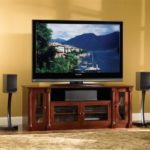Select the refresh rate of the TV screen
The passport of each modern LCD TV or computer monitor contains such a characteristic as the screen refresh rate. But even the sales assistant is not always able to explain how this figure actually affects the image, how the picture differs in 50Hz, 100Hz, 200Hz and which frequency is better to choose. However, the difference exists, and quite noticeable: the number of Hz significantly affects the quality. Sometimes it is worth a little to increase the cost of the purchase, but to purchase a more successful model with a clear image and smooth transitions dynamic frames.

Content
How many hertz has a good tv?
Do not confuse this indicator with the frequency of film-shooting, which is equal to 24 frames per second, or the indicator of tele-content, equal to 50 frames.The refresh rate of the TV screen - or scan - is measured in Hz (Hertz). The Hz indicator indicates how many frames per second the panel can show.
The higher this characteristic, the clearer the picture will be, without “blurred” movements and flicker.
If you delve a little into the story, then already obsolete monitors and televisions had a modest frequency of 50 Hz, not hiding the "smeared" scenes with the rapid movement of the object. Later they were replaced by more sophisticated devices with a 100Hz scan. The news completely eliminated the unpleasant flicker, but to talk about quality is still not necessary. As mentioned above, the TV content gives 50 frames per second (which is equal to 50 Hz), the updated models “finished painting” intermediate frames thereby slightly increasing the image clarity to a satisfactory level. But compared to its predecessors, televisions were considered excellent, and there was no better alternative.
High image quality will provide at least 200Hz when digital video processing projects already three additional intermediate frames.. Although the manufacturer promises that 100Hz is enough for modern technology, but this is not entirely true.It is enough to turn on two TVs with different frequencies: in comparison, the difference in quality with a scan of 100 and 200 Hz will be noticeable. But you should take into account the screen resolution. For modern types 4K TVs 120 Hz is enough.
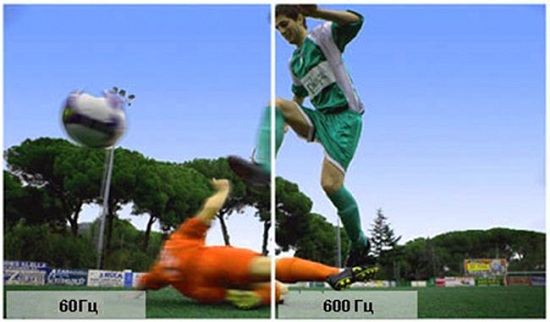
Technical description of the sweep process
To understand what the refresh rate is, and how the frames are being drawn, you need to understand the types of LCD TVs and monitors that are on the market today.
- LCD (Liqud Crystal Display) were among the first developments of LCD TVs. Currently, they are relatively cheap, as there are many improved models and new technologies. So, LCD panels are inferior to LED by comparative characteristics. The formation of the image is carried out using a fluorescent backlight CCFL. Such devices do not have good picture clarity, but when you scan more than 100 Hz, you can count on the complete absence of flicker.
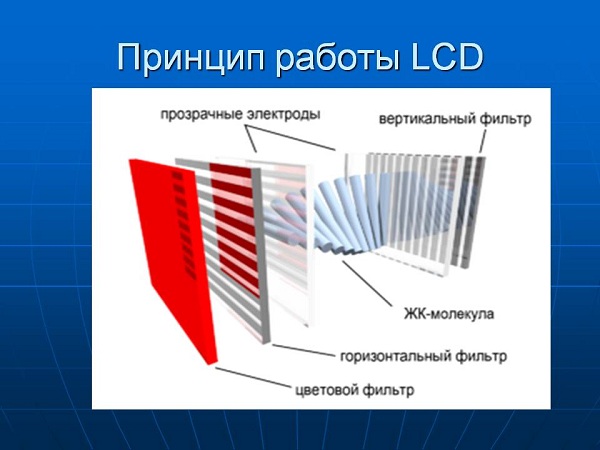
- LED (Light-emitting Diode) - This is an improved LCD monitors, supplemented by a new system of image illumination using LED-diodes. Such monitors have higher contrast.Please note: the placement of the diodes on the screen area can be different, which affects the quality of the transfer of pictures. The models with the markings “Full LED”, “True LED”, “Direct LED” have higher quality, in them the diode illumination is distributed over the entire screen area, while the label “Edge LED” means that the illumination is concentrated in the end parts. You can read more about these nuances in LED technology article. This TV will be much cheaper, but the image will be slightly worse.
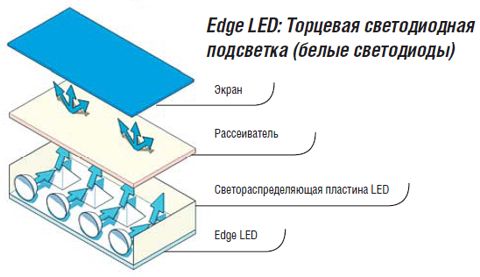
- Plasma panel (Plasma Display Panel) does not require additional illumination: plasma cells are illuminated due to the effect of ultraviolet rays on the phosphors. Plasma provides higher contrast compared to the two species described above and deep dark shades. The affordable cost of the panel is compensated for its fragility: for 3 - 4 years, the panel burns out a little, the image quality decreases significantly. Complementary to the list of shortcomings is the perceptible consumption of energy resources and frequent failures when detecting removable modules. Such a TV can not see hard drive orflash drive, headset and similar pluggable devices.
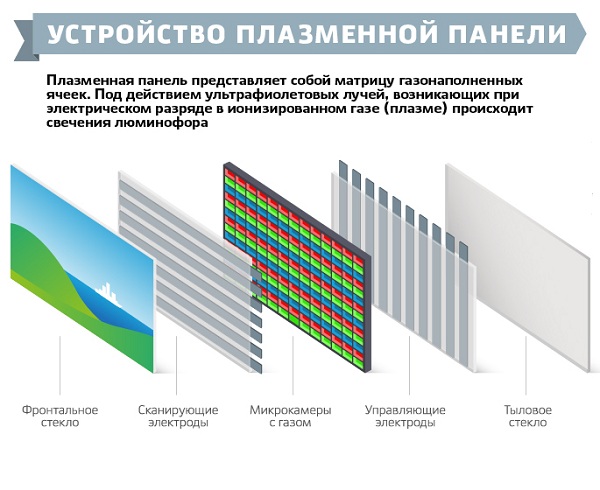
- OLED (Organic Light-emitting Diode) in the modern world - the pinnacle of technical tele-progress. These were the first curved TVs in 2015, but the extravagant performance was not in great demand, and after the usual flat OLED devices appeared. Manufacturers have achieved high quality images without any additional illumination. The advantages of this technology compared to LED are obvious.
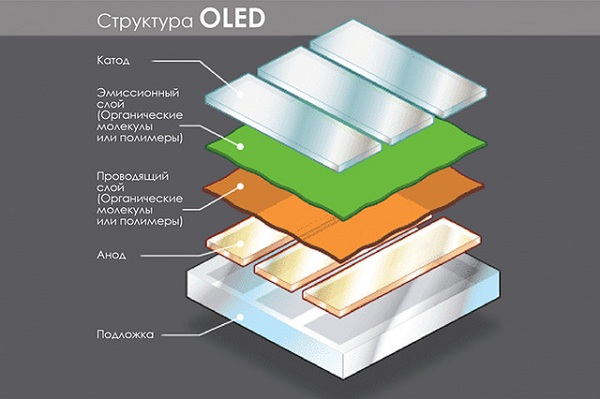
Now about the technology of the display refresh rate. The television line provided via non-switched communication channels provides 50 frames per second. Digital video processing allowed to copy each frame and show it twice, so a 100Hz scan was born. The technology allowed to exclude the most uncomfortable image defect - flicker.
Further development borrowed technology from computer animation, when the technique takes as a basis two frames and creates all the intermediate intellectually, creating a smooth and precise movement. Unlike the computer, the TV does not have the concept of "future frame", but that was enough. Additional frames are completed on the basis of the analysis of the past, which ensures high accuracy and smoothness of images. Objects moving at high speed, clear and not blurry.
What the market currently offers
The most modern today are the panels with a sweep frequency of 600 and 800 Hz with embedded Sub-Field Driving technology, which promises unsurpassed picture quality. There are many doubts about these characteristics. Distrust of manufacturers was born a long time ago, when such equipment was just beginning to enter the market. In those days, marketers were not shy about attributing hertz, when technologies for drawing images didn’t insert frames but simply black images that the eye was not able to perceive. Thus, the quality did not increase, but the sales of digital electronics went very well. Modern LCD TVs of famous brands correspond to the parameters stated in the passport, and here you should not doubt. It is more important to take care of availability necessary cables, allowing to transmit digitized channels of satellite or cable TV.
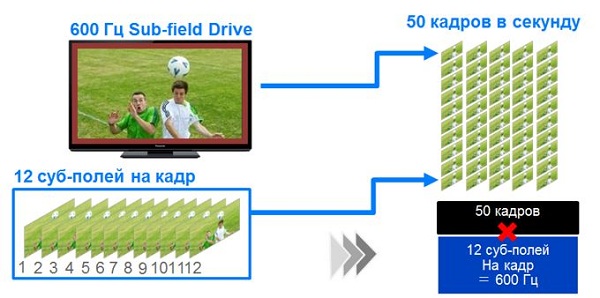
What does resolution affect
Speaking about the frequency of the sweep of the TV, not to mention other important parameters. In addition to the above indicator, you should pay attention to screen resolutionwhich also affects the image quality.The indicator is measured in pixels (p).
It should be noted that the continuous development of technologies, their improvement, leads to the fact that each new model is much better than the previous one. About five years ago, devices were at the peak of popularity at 720p, and models Full HD 1080p only appeared and cost twice as much, but today their value is almost equal. The modern market has been updated with a new HDTV resolution indicator - 4K Ultra HD, capable of displaying four times more pixels than Full HD.
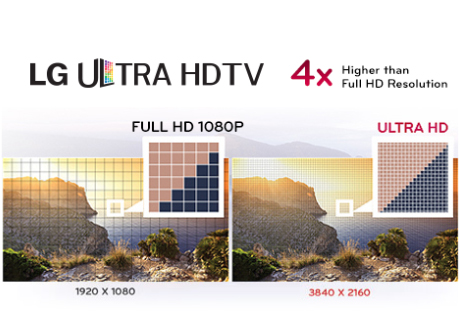
New UHDTV or 4K has more color reproduction, the 120Hz scan rate provides a clear, clear and realistic image. It is difficult to assess what is better: complete immersion in 3D or super-realistic pictures of the new resolution format. But do not write off Full HD in 1080p. Although the resolution fades into the background, it will be actively used for a long time. Most of the content is “sharpened” for this resolution, in contrast to the new UHDTV, for which the films have practically not been released yet, and the existing ones are not cheap. Therefore choose what resolution of the TV is better, can only be based on the quality of the incoming signal.
Moreover, the weight of such a file is much larger, the current cables, Internet speed and Wi-Fi router will also have to be replaced with faster and more powerful ones that can play and display ultra-precise video.
Summarizing
Taking into account all relevant parameters, several conclusions can be drawn.
- Scan provides a smooth image, clear storyboard of moving objects.
- Resolution provides a realistic drawing of each frame, when you can see all the details, exactly the color, the movement of water or people.
- Choosing which model of TV is better, it is worth analyzing all the key characteristics in the aggregate, so that both the screen resolution and the frame refresh rate are on par.
And yet, feel free to include and compare the image in the store before buying. Consultants will never be able to describe in words the quality of a picture of a particular model. Maximum comfort and satisfaction from the new acquisition will be at its best, if you approach the choice with a degree of criticality.

/rating_on.png)
/rating_half.png)
/rating_off.png)






